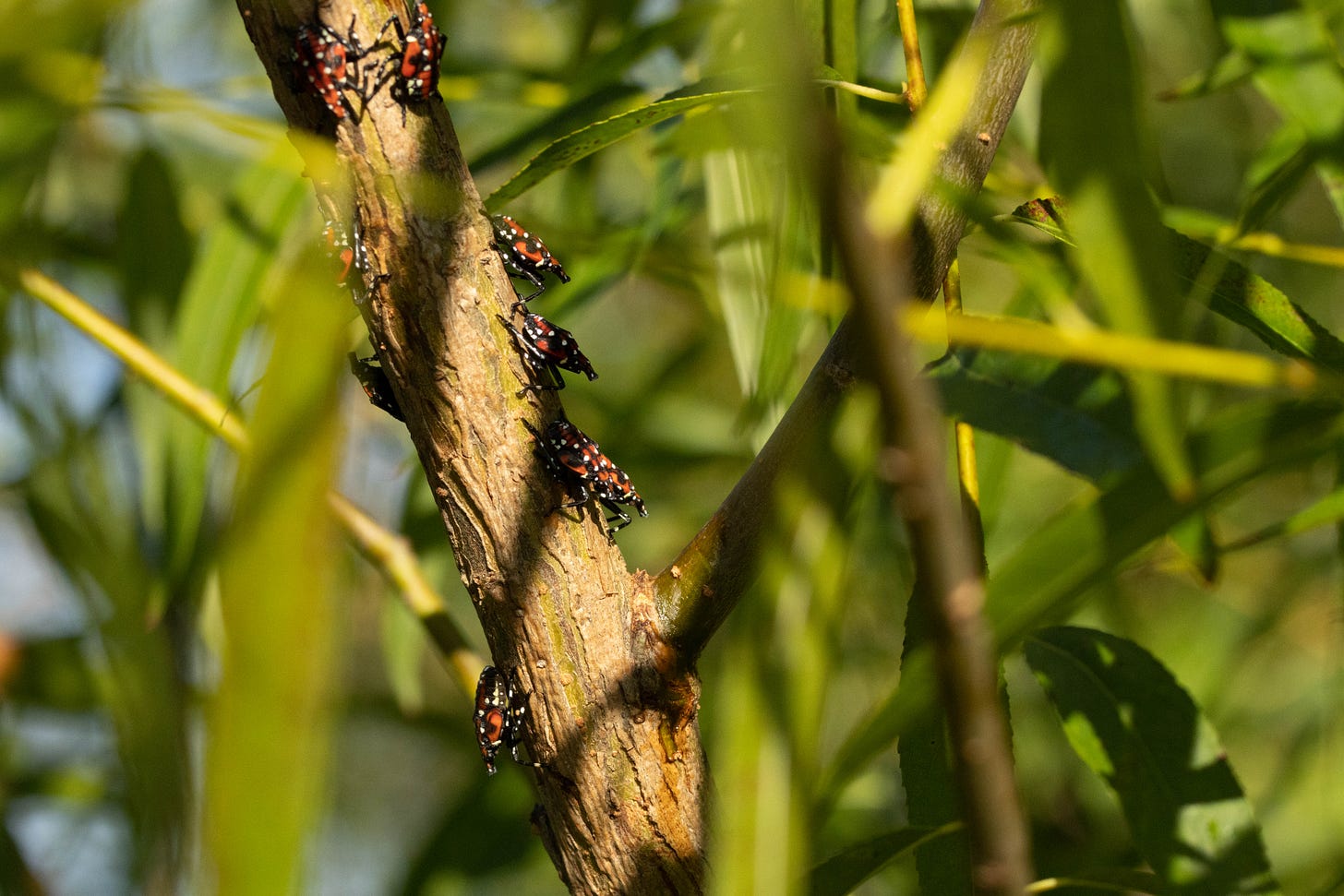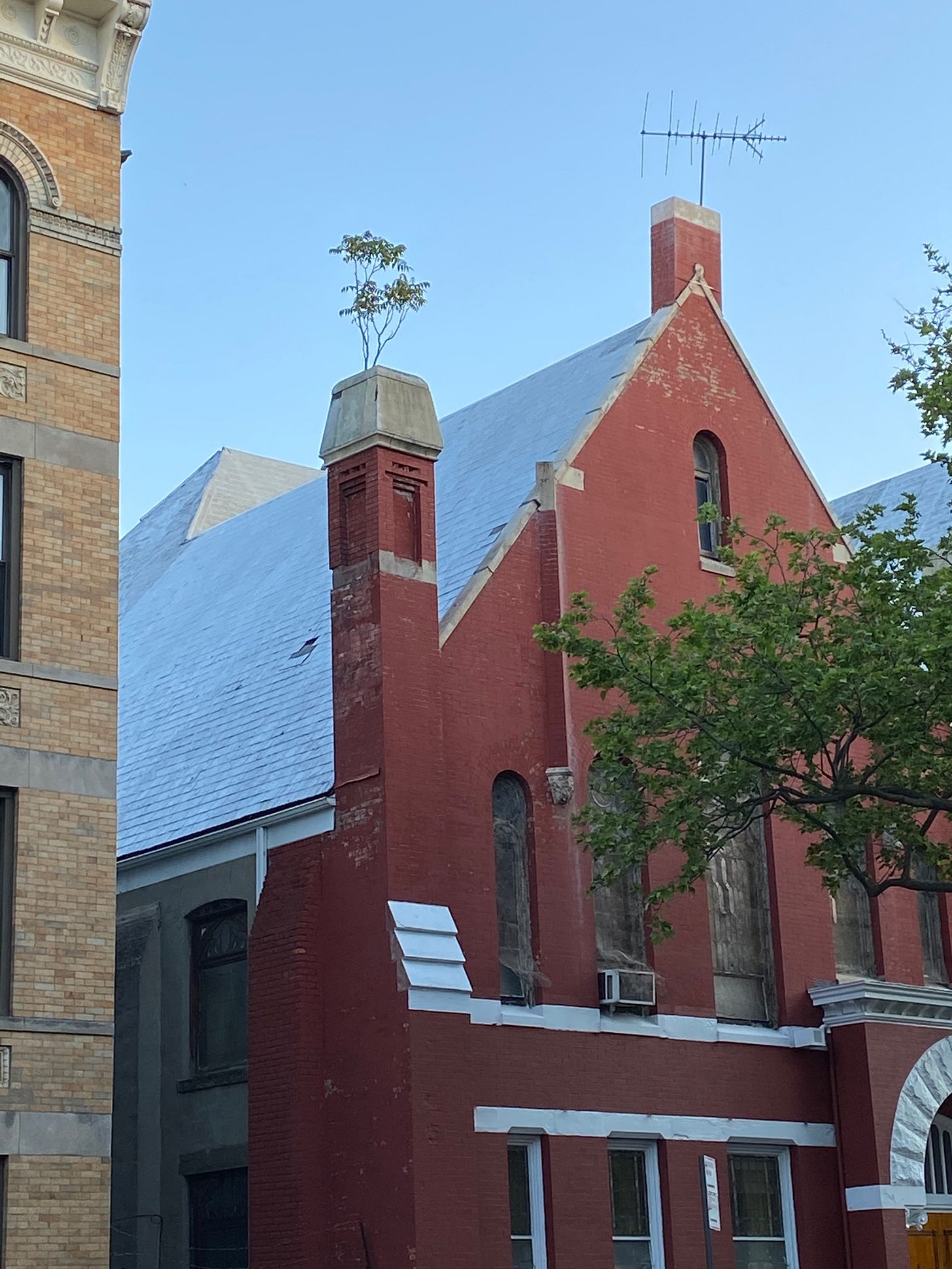why does something so cool gotta be so bad
spotted: too many lanternflies
i gotta admit: i sometimes don’t squish the spotted lanternflies i find. like, on purpose.
spotted lanternflies are the norhteast’s invasive scourge du jour. they’re native to parts of east and southeast asia, and first showed up in eastern pennsylvania in september, 2014—probably a stowaway in some shipping container or something like that. now, they’ve established populations across the united states, including new york city. they have the potential to be really bad. i can’t help but think that they’re also kinda neat.
first off, they look really cool, like objectively. the first three instars—the word for insect developmental stages—are small, black and white polka-dotted creatures that look like they’re doing planks and hop between plants like the hemispherical rubber pop up toys you’d get for a hundred tickets at dave and busters or something. the fourth instar, shown above and my personal favorite, takes on a vibrant red clownish look. the adults grow a pair of gray wings with black spots and a checkered patterning. they’re not especially good fliers; if you encounter one floating by, you could pretty easily smack it out of the air.
so, why are people so worried about them? well, the usda is most concerned about their impact on fruit crops and orchards. they’re pretty insidious: they weaken plants by sucking the sap out, and while they feed, they produce a sticky “honeydew“ that can attract more insects and cause mold to grow, according to a nys integrated pest management program publication. finally, they lay eggs in wax-covered masses that can easily blend into whatever surface they’re on — and if they chose to lay those eggs on an object slated to be shipped elsewhere, then boom, they’ve been introduced to a new place.
the average new yorker may have only recently started hearing about lanternflies, but the bug had an inseparable link to nyc even before it arrived. perhaps the spotted lanternfly’s favorite host plant is ailanthus altissima, also known as tree-of-heaven, or in our case, the tree from a tree grows in brooklyn. ailanthus, too, is a species that grows unchecked across the urban landscape, and can thrive even in abandoned lots and cracks in the sidewalk. i recently spotted a mature ailanthus tree at mount loretto unique area in staten island that was utterly blanketed with lanternflies. also here:
the bug might use this association as a defense, according to one of my favorite audubon articles. ailanthus is toxic, and, citing research by penn state researcher anne johnson, the article posits that maybe by feeding on ailanthus, spotted lanternflies are using those toxic chemicals to make themselves taste bad to potential predators. this kind of defense is similar to how monarch caterpillars become poisonous to other animals from eating poisonous milkweed, and it’s a pretty cool thing that nature does. it’d be cooler if it wasn’t an introduced bug doing that on an introduced tree, and then ruining fruit crops, of course.
if lanternflies really do use that chemical to make themselves unappetizing, then the situation isn’t totally bleak when it comes to handling them: simply getting rid of ailanthus might help, according to that same audubon article. then, the lanternflies wouldn’t taste as bad and birds would take advantage of the glut of prey, perhaps limiting the lanternfly population in the process. i did see a bird eat a spotted lanternfly once. i cheered.
eliminating ailanthus certainly seems like a rosier plan than some of the alternatives. no amount of squashing individuals is going to make them go away (and sometimes balk when trying to squish them because they’re a little too big and too pretty). worse, some of the techniques, like glue traps, are having the unfortunate side effect of killing other insects and birds (there are better trap options, thankfully). however, i’m not sure that saying “just get rid of the ailanthus!” is much better than saying “just get rid of the lanternflies!” seeing as tree-of-heaven is really good at reproducing and has been around in the US since the 18th century.
we don’t know what the long-term effects of spotted lanternfly will be on the eastern us; there’s still plenty of ongonig research to figure that out. it’ll probably continue to be pretty bad, maybe even *very* bad. but ultimately, it’s a sad truth that people purposely and accidentally move other organisms around the world, permanently altering the habitats they encounter and creating an entirely new landscape in their wake. if there was a villain in the lanternfly story, it would probably be us.
i’ve resolved that the way i can help best is to continue noting my spotted lanternfly sightings in inaturalist and invasive species monitoring programs so that people know where the bugs are. i’ll keep telling people to kill them (and to do so thoughtfully). if i see an egg mass, i’ll report it and get rid of it. but sometimes i might choose to enjoy the big, cool, pretty bug.
postscript:
after i sent this newsletter, the new york times wrote an article that was even more sympathetic toward the lanternflies than i. i thought that article was bad.



